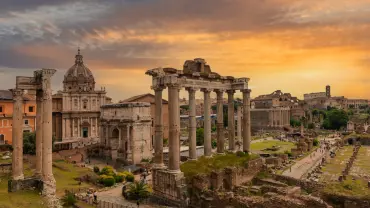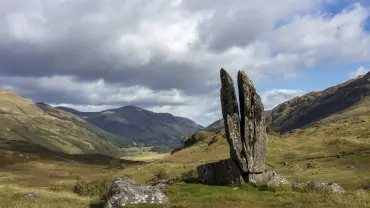They were hidden for centuries within verdant jungles and on serene farmlands. Hundreds of stones, sculpted into near-perfect orbs. Varying in size from a few inches to eight feet, each and every one is improbably smooth to the touch. First unearthed in the 1930s, these ancient artefacts have been known as the Costa Rica spheres, the Costa Rica stone balls and the Diquís Spheres. Locals simply refer to them as Las Bolas. And they’ve captured the imagination of historians, archaeologists, and amateur enthusiasts worldwide.
So, what’s the real story behind the stone spheres of Costa Rica? Who made them? And why? Read on. Because things are about to get a bit bananas.
Discovering the Costa Rica Spheres

Bananas in the tropical jungle of Costa Rica (Credit: AscentXmedia via Getty Images)
The story of the discovery of the Costa Rica spheres is truly bananas. Actual bananas. You see, they weren’t unearthed during an archaeological dig or expedition, but during the establishment of a banana plantation in the 1930s. As workers for the United Fruit Company were clearing part of the jungle in the Diquís Valley, they kept finding them: petrospheres. Stone balls sculpted into near-perfect orbs and totally smooth to the touch.
Since then, around 350 of the Costa Rica rock spheres have been found throughout the country. Ranging in size from mere inches to some eight feet in diameter and weighing up to 16 tonnes, most are made of gabbro, a type of volcanic rock, as well as limestone and sandstone. Their composition has been lauded as astonishing, with some spheres exhibiting such precision that they’re almost perfectly round. Since 2014, they have been recognized by UNESCO as “special objects of wonder and admiration.” And at least part of their story has been revealed.
Myth and Legend

An illustration of the ruins of the legendary lost city of Atlantis (Credit: StockByM via Getty Images)
Myths and legends abound as to the origins and purpose of the Costa Rica stone balls. Some locals believed their stone exteriors were vessels containing hidden gold, which led to many being destroyed. And there’s more.
One school of thought claims that the Costa Rica spheres marked the position of the mythical city of Atlantis. They also feature in the creation story of the Bribri, a tribe based in the Talamanca region. According to this, the ‘Diquís Spheres’ were the bullets in a celestial blowgun belonging to Tara, the god of thunder. And that he used them to deter the Serkes, gods of winds and hurricanes, from entering the land.
Aliens also get a mention at times, with some claiming the stone spheres of Costa Rica were placed there by extraterrestrial sources. However, the very terrestrial nature of their stone suggests otherwise.
Pre-Columbian Origins

Diquís Spheres in Costa Rica's National Museum (Credit: MAYELA LOPEZ / Stringer via Getty Images)
Over the years, archaeological digs and scientific analyses have provided some insight into the monuments. For one thing, they weren’t found in isolation, but rather within Pre-Columbian settlements. Along with the ‘Diquís Spheres’ themselves, excavations have unearthed entire residential areas with paving, burial sites and artificial mounds.
Radiocarbon dating of materials found at sites associated with the spheres suggests they were produced at some point between 500 and 1500 AD. Although a more exact date remains elusive, they’re attributed to the chiefdoms which inhabited the Diquís Delta in that period.
Scholars have proposed various theories regarding the purpose of these spheres. Some suggest they were used as status symbols by the elite, while others believe they had astronomical purposes, aligning with celestial bodies to mark significant calendar events. Another theory posits that they served as territorial markers. Despite extensive research, the true purpose of the ‘Diquís Spheres’ remains a subject of speculation, reflecting the complex society that created them. What’s more, this is only one of several mysteries still shrouding the spheres, including how they were made.
How Were the Costa Rica Spheres Made?

Costa Rica Spheres, San Jose (Credit: EZEQUIEL BECERRA / Contributor via Getty Images)
There are two aspects of the creation of the Costa Rica stone balls that continue to defy definitive explanation. Firstly, there’s the craftsmanship. How were they sculpted into such near-perfect orbs? And ones that were so smooth? Research indicates this may have been achieved using tools made of the same rock as the spheres, probably hammers and chisels. Some think the rock was heated then quickly cooled, loosening its outer layer. The roundedness may have been judged using wooden arches, while polishing the rock using leather or sand might have smoothed their surfaces.
But where was the rock from? The heaviest of the spheres weighed roughly as much as three and half elephants, so how was it transported? Some suggest the stones used were those found nearby. Others believe that such rock was only found several miles away and that it may have been moved by rolling it on logs.
Modern Significance and Preservation Efforts
Today, the Costa Rica spheres are a source of national pride and something of a national symbol. Their designation as a UNESCO World Heritage Site in 2014 underscores their importance and has bolstered efforts to preserve and study them. These efforts ensure that the spheres will continue to captivate and educate future generations about the rich pre-Columbian history of the region.
The Enduring Mystery of the Costa Rica Spheres

Pre-Columbian stone spheres at the National Museum in Costa Rica (Credit: YURI CORTEZ / Staff via Getty Images)
The stone spheres of Costa Rica, ancient artefacts carved with precision and care, continue to be a source of fascination and wonder. Despite the progress made in understanding their origins and methods of construction, the spheres remain shrouded in mystery, inviting both experts and the wider public to ponder their significance.












